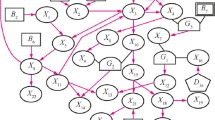Abstract
In some domains like industry, medicine, communications, speech recognition, planning, tutoring systems, and forecasting; the timing of observations (symptoms, measures, test, events, as well as faults) play a major role in diagnosis and prediction. This paper introduces a new formalism to deal with uncertainty and time using Bayesian networks called Temporal Bayesian Network of Events (TBNE). In a TBNE each node represents an event or state change of a variable, and an arc corresponds to a causal-temporal relationship. A temporal node represents the time that a variable changes state, including an option of no-change. The temporal intervals can differ in number and size for each temporal node, so this allows multiple granularity. Our approach is contrasted with a Dynamic Bayesian network for a simple medical example. An empirical evaluation is presented for a subsystem of a thermal power plant, in which this approach is used for fault diagnosis and event prediction with good results. The TBNE model can be used for the diagnosis of a cascade of anomalies arising with certain delays; this situation is typical in the diagnosis of medical and industrial processes.
Similar content being viewed by others
References
C.F. Aliferis and G.F. Cooper, “A structurally and temporally extended bayesian belief network model: Definitions, properties, and modeling techniques,” in Uncertainty in Artificial Intelligence, edited by E. Horvitz and F. Jensen, Morgan Kaufmann: San Francisco, 1996, pp. 28–39.
E. Santos Jr., “Unifying time and uncertainty for diagnosis,” J. Expt. Theor. Artif. Intell., vol. 8, pp. 75–94, 1996.
G. Arroyo-Figueroa and L.E. Sucar, “Medical diagnosis using temporal probabilistic networks,” Computación y Siśtemas, vol. 5, no. 2, pp. 109–119, 2001.
S.F. Galan and F.J. Diez, “Networks of probabilistic events in discrete time,” Int. J. of Approximate Reasoning, vol. 30, pp. 181–202, 2002.
G. Arroyo-Figueroa, Y. Alvarez, and L.E. Sucar, “SEDRET-an intelligent system for the diagnosis and prediction of events in power plants,” Expert Systems with Applications, vol. 18, pp. 75–86, 2000.
E. Horvitz and A. Seiver, “Time-critical reasoning: Representations and application,” in uncertainty in artificial intelligence, edited by D. Geiger and P.P. Shenoy, Morgan Kaufmann: San Francisco, 1997, pp. 250–257.
G. Lamperti and M. Zanella, “Diagnosis of discrete-event systems from uncertain temporal observations,” Artificial Intelligence, vol.137, pp. 91–163, 2002.
Judea Pearl, Causality: Models, Reasoning and Inference, Cambridge University Press: London, 2000.
G. Arroyo-Figueroa and L.E. Sucar, “A temporal bayesian network for diagnosis and prediction,” in uncertainty in artificial intelligence, edited by K. Laskey and H. Prade, Morgan Kaufmann: San Francisco, 1999, pp. 13– 20.
K. Murphy, “Dynamic bayesian networks: Representation, inference and learning, PhD thesis, UC Berkeley, Computer Science Division. July 2002.
S. Hanks, D. Madigan, and J. Gavrin, “Probabilistic temporal reasoning with endogenous change,” in Uncertainty in Artificial Intelligence, edited by P. Besnard and S. Hanks, Morgan Kaufmann: San Francisco, 1995, pp. 245– 254.
U. Kjaerulff, “A computational scheme for reasoning in dynamic probabilístic Networks,” in Uncertainty in Artificial Intelligence, edited by Dubbois, Wellman, D’Ambrosio, and Smets, Morgan Kaufmann: San Francisco, 1992, pp. 121–129.
J.F. Allen, “Maintaining knowledge about temporal intervals,” Communications of the ACM, vol. 26, no. 11, pp. 832–843, 1983.
K. Kanazawa, “A logic and time nets for probabilistic inference,” in Proc Tenth National Conf. on Artificial Intelligence AAAI, 1991, pp. 360–365.
A.E. Nicholson and J.M. Brady, “Dynamic belief networks for discrete monitoring,” IEEE Transactions on Systems, Man, and Cybernetics, vol. 34, no. 11, pp. 1593–1610, 1994.
E. Santos Jr. and J.D. Young, “Probabilistic temporal networks.” Report AFIT/EN/TR96-006 AFIT, 1996.
Author information
Authors and Affiliations
Corresponding author
Rights and permissions
About this article
Cite this article
Arroyo-Figueroa, G., Sucar, L.E. Temporal Bayesian Network of Events for Diagnosis and Prediction in Dynamic Domains. Appl Intell 23, 77–86 (2005). https://doi.org/10.1007/s10489-005-3413-x
Issue Date:
DOI: https://doi.org/10.1007/s10489-005-3413-x




